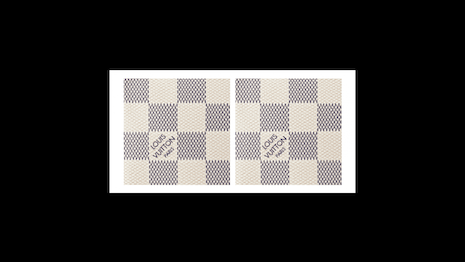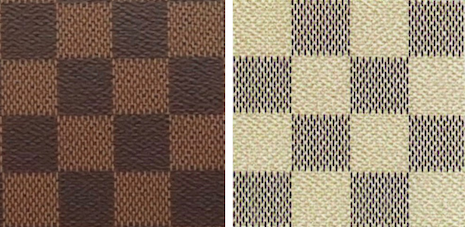By Milton Springut
As noted recently (see story), Louis Vuitton Malletier has failed to prevail in its seven-year battle to maintain trademark rights to its Damier Azur checkerboard trademark.
While its iconic brown Damier pattern is surely recognizable throughout the world, Louis Vuitton’s more recent cream-and-blue Azur design – for use on leather goods, for which it obtained a registration with the International Bureau of the World Intellectual Property Organization (WIPO) back in 2008 –has been under attack continuously in European Union courts for lacking the qualities required to achieve protection.
 Louis Vuitton's white-and-blue Damier Azur pattern. Image credit: Louis Vuitton
Louis Vuitton's white-and-blue Damier Azur pattern. Image credit: Louis Vuitton
Successful designs can be invaluable to a brand, and fashion and luxury goods companies look to intellectual property law to protect their designs. Among the available legal protections is trade dress – where the design itself functions as a trademark, distinguishing the product as emanating from one designer or fashion/luxury goods house.
Trade dress can be a very powerful form of protection, but only if a company understands how to gain and maintain it.
In Louis Vuitton Malletier v. European Union Intellectual Property Office (Oct. 19, 2022), this most recent decision from the General Court of the European Union, the court found that Louis Vuitton failed to proffer sufficient evidence to prevent its registration from becoming invalid.
We use the issuance of this decision as an opportunity to illustrate how a brand can obtain trademark protection for its designs, and attempt to avoid the issue that Louis Vuitton faced to ensure a design is protected, essentially in perpetuity.
 Louis Vuitton's brown Damier pattern alongside the more recent cream-and-blue Azur design. Image credit: Louis Vuitton
Louis Vuitton's brown Damier pattern alongside the more recent cream-and-blue Azur design. Image credit: Louis Vuitton
Trade dress basics
Trademark rights are obtained not through creation or invention, but rather through use of the trademark in connection with the product.
As a form of trademark, trade dress can extend to designs of packaging, portions of products and even entire products.
Once a design is found to be entitled to trade dress protection, the brand can benefit from that protection forever, or to be a little more precise, as long as the trademark owner keeps on using the design in connection with its products.
To be valid, every trademark must be “distinctive,” which means that it must be able to distinguish the goods as those of one particular company or manufacturer.
Product designs that are “generic” are not protectable. In the context of product design, generic means that a design is so common that it cannot be said to identify a particular source, i.e., it fails to function as a trademark, and therefore it is not capable of being registered.
Some forms of trademark, such as an arbitrary word mark, are protected immediately upon first use in commerce. Such a trademark will be protected once a company commences use of it to identify products. This is not the case with product designs.
Product design trademarks only become distinctive by building up commercial recognition, termed “acquired distinctiveness” (oftentimes also called “secondary meaning”). So initially, such a trademark would not be subject to protection under trademark law.
In 2000, the Supreme Court held that to claim trade dress rights, one must show that the consuming public has come to recognize the design as uniquely associated with one company – that the “primary significance” of the design is to identify the product as that of the source company.
So, for trade dress, the key question is – does the consuming public view the design and associate it with only one source?
That level of recognition usually requires the investment of a significant level of promotion and sales by the company and, in a legal case, a strong showing, including through potentially survey evidence, that the consuming public associates the design with a single source.
Generally, it takes considerable time to attain secondary meaning, so it is crucial that the brand maintain good records of its sales of the product, the appearance of all design variations (e.g., catalogs), and all advertising and promotional efforts, including any notable attention via social media.
EUIPO v. Louis Vuitton
Louis Vuitton sought to prove that the public in the European Union recognizes its Damier Azur design as uniquely being associated with Louis Vuitton.
In a prior decision, in June 2020, the General Court determined that the European Union Intellectual Property Office (EUIPO) Second Board of Appeal correctly ruled that the checkboard pattern was not inherently distinctive. Louis Vuitton appealed the matter in an attempt to prove that the mark had instead acquired distinctiveness, therefore defeating a claim that the registration of the mark was invalid.
In response, the Fifth Board of Appeal held that Louis Vuitton had not demonstrated distinctiveness and dismissed the action. Now, Louis Vuitton appeals yet again. Thus, the only question to be decided in this latest decision was whether the Fifth Board of Appeal was correct in determining that the pattern had not acquired distinctiveness through use in the E.U.
Although E.U. law differs from United States law, there is significant overlap in the trade dress analysis, and in its decision, the court laid out each of the factors that it considered when examining the evidence presented by Louis Vuitton.
In turn, the court assessed: the value and market share of the Louis Vuitton brand, the information concerning the history of the Damier Azur mark, sales invoices, excerpts from catalogs, advertising campaigns, media coverage of the mark, evidence of the use of the mark on the Internet, expert’s statements, opinion polls, and evidence concerning infringement proceedings.
Examining the factors, one by one, the court concluded that the evidence Louis Vuitton submitted was insufficient. The overarching issue for Louis Vuitton that severely affected the strength of its argument, and a major catalyst leading to this appeal, was how the court determined which evidence was relevant.
Although the court made a point to say that it would be unreasonable to require proof that a mark had acquired distinctiveness in each individual member state within the E.U., it nonetheless concluded that the Board of Appeal did not get it wrong that it could “examine first whether the contested mark had acquired distinctive character through the use that had been made of it in Bulgaria, Estonia, Latvia, Lithuania, Slovakia, and Slovenia (together, ‘the member states concerned’),” before proceeding to examine the question in any other E.U. member state.
Notably, these countries, along with Malta, are the only member states that do not have a Louis Vuitton store. Consequently, each piece of evidence Louis Vuitton presented concerning the sales or promotional efforts made in any other country to show that the checkerboard mark acquired distinctiveness in the member states concerned was of little assistance.
The court stated that while Louis Vuitton may be one of the most significant players in the leather goods industry in the E.U., this alone does not provide direct and specific information regarding the contested mark.
Louis Vuitton presented sales invoices showing around 200 sales for Slovakia, 30 for Bulgaria and 20 for each of Estonia, Latvia, Lithuania and Slovenia.
The Board of Appeal found that this was only a “very small” number for the specified countries. In the present case, Louis Vuitton stated that this evidence is only a “selection” of invoices, and that the actual volume of sales to persons residing in the member states concerned is, in fact, higher. The General Court was not persuaded, reiterating that the burden to present evidence was on Louis Vuitton, and the invoices presented were not themselves sufficient to demonstrate distinctive character acquired through use of the contested mark in the member states concerned.
Additionally, with the exception of Estonia, Louis Vuitton presented little evidence that magazine and advertising materials, both physical and online, reached the consumers in the specified countries.
Louis Vuitton argued that in the EU, consumers “engage in homogenous behavior . . . particularly because they travel and use the internet regularly,” and that the court should put more weight on evidence that the mark had acquired distinctiveness with consumers in the nearby countries of Poland, Sweden and Romania. But the court rejected Louis Vuitton’s position as being too general in nature, and that Louis Vuitton failed to meet its burden of presenting sufficient evidence to show that, due to geographical and cultural proximity, consumers in the relevant specified countries had knowledge of the Polish, Swedish, or Romanian markets, or that these areas constituted one and the same market.
Notwithstanding the court’s determination that the volume of evidence that Louis Vuitton presented for the member states concerned was lacking, the court stated that the evidence equally failed to provide sufficient information as to the intensity of the exposure of the relevant public to the mark.
Louis Vuitton did not submit information capable of demonstrating that a significant proportion of the relevant public in those member states was exposed to those advertising campaigns, concerning, i.e., the number of magazines distributed in those member states, the frequency and the times at which advertisements were broadcast on television or radio channels and statistics on the audience figures achieved. The mere existence, for example, of a website or advertisement, according to the court, was not capable of establishing the intensity of use of a trademark. Sufficient evidence would need to show more, such as the number of visits or interactions with the website or advertisement during a certain period of time.
With such a high evidentiary bar to clear for showing the mark acquired distinctiveness in the eyes of the public to obtain trade dress protection, Louis Vuitton’s lack of evidence proved fatal to its case.
This high evidentiary bar is not by happenstance. Wary that trade dress rights could be abused to monopolize designs without patent or copyright protection, the Supreme Court and Congress have imposed strict limitations on the availability to obtain such rights. The law in the European Union is not to the contrary.
Ultimately, because Louis Vuitton could not present sufficient, relevant records of its sales, advertising and promotional efforts, or Internet and social media activity in the specified countries, the court concluded that Louis Vuitton had not demonstrated that the contested mark had acquired distinctiveness through its use in all the member states of the European Union as required by law, and the action was dismissed.
TRADE DRESS CAN be a powerful right. Many luxury goods companies, including Cartier, Montblanc and Audemars Piguet have used such rights to great effect.
It is necessary, however, to invest early in an effort to lay the foundation for securing those rights to ensure success in the future. That is especially the case for trade dress rights, which depend heavily on public recognition and association of the design with the designer or fashion company.
Understanding the legal requirements for gaining these rights is the first step for brands protecting their designs through this body of law, while engaging in sufficient use and documenting the same is paramount going forward.
Milton Springut is partner at Moses & Singer, New York. Reach him at mspringut@mosessinger.com.
{"ct":"tnundasLeAdMxY\/MRAkizO596NL5cfQrxXhJCmyMTj\/ZKBWFTcvkptl0Ck6aif6HmOpimtpdCnKPQTCZ94H2B2h3up\/JKYUxmCR8yh7MrtdjG91Ekv7nii82FpMrII0E3V18bti9nYbHkOAFeOnVjgVG\/bj4otCIVh1GkBNiPY9haSA\/FeQnJ8L1DKb2tUt4m+9YDIHV0xtBsQZ2qGTbLNjPuE5xmNLLB92M7qOb5mNHINbAZ\/xXFfjPNw6Qs0M7K7tBfx\/iNkTSHyO\/VqbFijcjnm0XRl6uCt77aahGUe0HQBFn85achfM5eeRrAFWvLN1JU9isK6j2HAxsyUnktwoXIZX\/JsXO+VfI18YQlqQnoGSah5yqEb0Y9w36DgeEhuYpcO0Izf+4JqSYfmAU\/zJ6+aVJ3\/4PStcJVGAWyNfiZg347RRrU8RshaxdhFokRi3jYe50+DM6sYXMvv5EgHcuPV4F3WhFiHSrsqEQMfu8HD\/qoAfaJE4akunMSujfAdXRomiV6s0+f8JPtMHpgWwvznvMJcaiz4T8CfvkKtsN3w7USrUr0IAsmS8XGro1rFZ6h93wmPz20tRxb8TNZcPVaSKysNj7pwHZPtj4Fx0mfM4LcH1QIJdrFEHffER91b6GkmzXmg03mZpUP3bYi0u0HWGpxTcNF9brBOc9U6ndsECs5wzN9u63P5syJ1i4dJrfxfYyKsgwg29tkZ4DL5iZjOwgqEJ3lO9llUfA\/3ZZQCGmPXswDXAfjNR0lnGqx53\/1iBKRnt9BImabTt8CKIu66oK\/jglB3XCZfSEC76BNFdv7AMnF5m\/nqNZnz4ug\/5tzYf+ZU+D5g+nQv595k63TF5C6UMH53d5\/bVM\/r2P7i6lv7Vkc6N6fTTh4REmaFSukobfTp0P6skphwrGt2U34qCmYd9FOQ6klUyOVEIpQN+H36AqHtvDGHaotuG462mDKFLNiYNXBRus1uH948xQNM5CA\/45aP+WnrvpnPAP3sFeA+NZzhZH2Nu0aUD92HwA9YPnfMxjJWaDKgYy\/NkFb9AVp+El\/dIVqj+5\/1r6diVaxzmOBX2oSyZkLTn45FmqNE238IgKFQtuJbMQ3viCuuIauyP+s49UsMYk2FzrziHsvlnq1e3xpJ2XOnFxzWYPsCiki8dZaIateMHuXn\/a6aoDYWmpcQDVRNb\/juH7R2Mz6pFOTLp5AiZJt40CQ8rXIutypuzQNpOeOqw7cC1O\/8YljbwEbJaDHHVeQNbDBEZN48RlhYZBZ4lwf3qBSaA0W6FC7k6B5gp9nL1LISZQ53BnEiBbafGVm8AMSagLHXPb5AMMqGyMZanj93VS7gcghrjEUq5r8I2xTm7P2NLcno\/GDWjZNx7a3GSfi0+IAMmpUI7B3WZ+DG1gEbkmCeJdIT8NI9aQpXTgn1ojzdfRBrTsA7ocieymS79FkIfPyVIbNKAWdBRFEO9lrIiYfrxrcR7UsZ8\/wRBsu39K17y7OT5xU7YMveF9RF17IaMpEANhAWztX2P6455VPOBfX7I\/xPirJn36MnYF6TvF5whBpxsCdzR2YtpjVRGJmXt92pGv\/YEnrbiZi6fYX9LBA7sqee83hh+Oc3XzIdBRHWxKR7zCESUDJD4dhknFLPeySGqdo5WHcCZIbxuc2vibKLXHANZDnSkVMMPT2x4kR9u2QBMNGy+kRt3oPqaTRyO762hjvdNbkoiY+84nOSrll+HH662JkZvRU+XHLYBygqRB4idP+PtDmey0gh64YUec1\/oyihYoeQUCRGXtplIlC\/+48tdW+WLpVPHyBWJ+iYRqqZSdl5DGzV9LMdOAAkxqlev8Pit2zBDU+x2ywcs62aA1wEkhHROdcnIgA0DfqoXcVjaIhLbU5Te7r0tG8N0Y4hAqABSD3+wQrHmlV\/0mWj+keybBV99WI47tIKIyKfqys5sqVfA7giX8HR2ZGB3YR7eq+I25J+pD14yfFUzxsShxEdHt1UllyiOtZBhhlTKJnND79QrLrJ40ULF7bH+OagB5salEzkkXnHzGVK\/cd8CMITJLrcMHiiDg2BGd5TGSPuZmnv8\/YziIQIBOVwddeQuEY59vWX7vmMjGXe79hSmJh6QtiDyUbdePLPK+fQkPBEH5unG5X\/s632V3+SgQq9qDyu0K+UJ+2S3GERGBrsYDFj6bi5jL3kpb9ooX6\/u5anDnQNHIXF6A2\/nzgnbUg\/uWD+C38fouxjYbpx4RjRewr3uVhsXnp0bSE36h+UcOa1mDZE5k\/73sOHGfV7o7HnDxS5A0FkHWmGqAtH2tJ8T9kQk693gbHCraANsPXEBAbJUja7zZ4BkDVpsGrJHo0qFjwkc55p5uUGigqgBn\/K6HN9TZFQcU0ILizxE87oaKqeGTcWagp5M\/g2kRrkrINUgJa\/r0ZXdk+iWd5G8WzqncKrjds6xYMM0FH6M\/BEg85mupH4xQ5XDr3DZhCKnuXOm9crnvk2fqsTPBBkt7fcDUb6ez21rGZs4dZSfrJrlkGw4FQvtITavXKPbXat4I6GqDRa0Oe39y\/mHgOUdsZ\/iDNUzsNpe\/ZAatbP9Kl8BUJ+V06+3fB4mm6TAPpMsie1UJi+2jQ4eFtiQjDzsF0JEhCDJxFzeEysAFd0bYxlaOn3BSAEDKMqVsfbw6AWFKDaAn7hBi7W9Q3fuvbD14SjyFGWjfwBa67FF2khaxeefk7Bq7+o1awSXImQmOolYSHaP4wJ+PYTy77Hve\/6Xjnon1JBxG4f+EIbFICuUsgr2emDJr2qFNc6BCEvWcY3jUE7h+3bSM60I06t6meqZV5uw2vN0kNoIxn9JsSDwBvJq83ECQufhvERAJFBNIm5PqKbf3+3+qUdI3RZifrcT\/B1XWLuDYwmfmCBlKbp1XNJiwP8RFW+tVerNYU753P6SvQhfh6JRzL1w6cKSUqpNhmxquRHUV8+DYWpaIL8V5j0PF5txvHhkgmaLqtE6WlP1eqtxxu0uJNbmvWrtTyDDJ+bb6IsDAVrUWUwqiyMyyVSsXsvTE8GeqCX2dJ5Mr\/l832lpfQ9jhHKLdmndnnEzETe4BrtEsssel4DTV8A6fxK8LvbpVo2xfINlBZvrNXuohvCmxJXQPmklt1SXuRcJWiBgbc4nCwuFT1QP1FzkooWNlMEQNb1\/RiDUXCwcu9dIL4TV6HS9xEKppWHueLssGi6GIjNIbfKBlkZClZQKRLKssGlh774qbuGUP78EhR5eJGIVbROkDeHpIjB937na5QI3ZUg2PnC2fKPUd2uWSVY27cpVIjAbXVDFUm+D7J8AEqWKdYjLmeJBvej\/VZVA4aEjXrANONtEclAAsqul0cCGZZqsjAmEl6YG5z4oOkoW9aCY861KaldRwr1VdncTiSgT4L8IC4bKR44l0XjtkZaef7jDdR4IwC4XBNHrrxutXFS3805MLYbE\/9jBXKj\/9A4wZygnVlf5YUruYwW5QOZyNmdc82X8DvXDH2BLGgpyqtnnhf9qRtRPUgvEUtinsJ++A1Ich1T3mkP4IepjM\/tYUfvq0aFut7Rl7Lw7UVSWeOnTBFY1uAqprMxqYob4mppTroge4AqCfRHjlhVFxGDuyhP0I\/dfJoUUmb8plIkLsIvyyvfhY6Wdz8m2qkwDVilRPcuC8ZLYIOGDeWJcHAWxHInwYp6DWQzRZmcg2\/XF\/huWKo7Wzho\/17ccJfN+Z8Wy5K79aYquz5Lrm0t4qbIxDuPPLo+xOwGCU6kWqJOoEJCfGNsW91BTxftfQaYIbzndG\/Jd6fDpEFhd2zYKeMsE\/5LXqZQP7p5oarO3nY3ipenaDjI+rCwwF5WqB2gzlkwOusf5KVOKb+LCGL0LJziLgPDBGggVsqOKs\/N5SE7CsdEJKW2Woye2dZB6YLWTyRtrCw71JmGC+mu0wVfVrOZMKcEn4\/YAj\/hnEQFLi0Syd\/EDQDvKBPuytoIVEaYeN+5KLZ2yD0Lcos\/lNuSTahzexzaloKdspGDpXD8gvw2RTuSLNEurS7R\/VvZiwrQy4yYzw77cyYavsvAfBUKeX7aRakeJ3v0xZwO+FfLRDtIQYsPsrW4Fgq52KqRCWurnYgIJ6+szkDzwjA3YWcpKE8xnLphXaT823q8AXvx4cbt5\/Gry+Cr8b96bkLsISMFzNyw579W89\/oHs2NM1iFcMDE2rk\/801R6V+k28SoQrz+J44WEq1dZ\/TcKka66Q\/zESBMEBAK8RE02I4GJRyJkHzLy8p3alXa\/q2hq4zZV16QCaPW0gNUjTElphGkENo0E5rg\/5+WPaq7Y6yBpOUs6Gm46hr5AlQgr3meeRl9F\/w7u3blj6Q0b0d6QuNA4YcC6nGq5fbhoJkeBm+WdSdkklZlBN5mSI5eKcHJKZLx53JOJJPf\/AvP\/xwFylpXZQ+saO8n\/UetnUvCONtqlYPNEgnb971DTT7206iBcfW47zoh3UlBzVi4TpgTtMFl7jCTWTuqEEmX\/ys0lOvQnTVgo95aWd51LiH+4tV\/DAWm7DuXSstQFNc\/428ggecn6dbBKsrLWUyYFv5T3dOW5vnQ+3kziNgINPjl3WaMtY+zRRgW6ZWMmtxalWkDwi9nWyFFgJvATRBkzc9fWI4M7YlTEnLAl\/7zNNvGkpswc2xM8b2h\/to0TxQoWeHm8AgUhAWb87z4Mmw8COBe+fFzJZTNgNNchuAstILEbnJq3W\/CIbKiLjv36mibvZa9cj\/WTUyx5k1LJK+Nklxe++3bVLWprOj+dQgAMi9h\/8h115r\/fVSvE1n1i52dx6H5iSC5qEVEw9fo+k0uD3QeUMvLHu8gKYjyP7XFVf+\/LUi8zVa0xYcqnh8md+m1NQ1I63hZ6e11YrXgUqIzQ618HDI1PpX+T8trabwT+FxJeivWY2kpLwLu0hGVUcSyiDENhmcs0gfzk0fjZYOgsxZ2FCEjS26eeB+5yPvtPmPcSApwrU7p1aafZPgGSNOTXEWu5JlED0yc5AuszwdXkt1rf6KAS5NVdIof3A6zUqRW2\/UpSLGcUGh1QDAYyGFjNHQQOpO\/ILD4tjnAuPc2WYILVXUgYUp98uffLv0RwBsUVbPIPlANzxKAhd8BHsIkiDAYftQCE2LMwNpf3f0TldluMtMmZvEO9NRi9aGc93vpKw32H0L\/5P4vwMQpAbP269NBk+0dxFytK9268veviaPJdX8SyUOWvCPrZmL3a8Z\/f9NKSChfG8yL2rK7BR36wypZnXbUPjY7sFBajH56Y\/wWUjuNyFHtMp8gIR4KgHwlNvUcVtnd2+qV2wjdN3Ydwy3g1nWa+ZOqbRU4tY+cUERdZY9fY7TavZgViSpJipM9bML5w75BQSCv9gHpiAKwY3I6NcdqV6TmdVm7DhUBk6MigQ28nM0bzneE0pp1rRY\/Tm+YVmZS7laAmA9E0g6tQ\/ICTOkHhoncDL1NjIpQHVfh0jMIDFkasalBGinnvZucz54m8TpdasB1b7fOTjD3dckyj7X\/hD9H7qsMwCVJM9eK\/NgEfgDV0CQzTwLH6HoZ60TxP2yPISdQbH5jYJry7\/\/rpJ+QjvUsoLak+ZNLcK4j6lS2\/a0mr669I4Hqdxc6nPwYYZL+AvNI39wwNN0munAlzCW7Pycsy\/6YKSKucHry9y6LDb8Au6CyjYeGA5+e8BY6CYSssDDKMW+TjD2vAkvScBICQzuJgXx6pmUKy4LnHN1l14BcKDDeicfjj\/PvaWyPRajXvoIws6dUoyFMkkF5mzqUzSOLVXUB98u8Ft4sFqudCp86PaJRBBdp\/YBB2QO\/UeLyZBuLJdXC3nBjIv4wcdQIQvDAId60F5LBgsEFXEgCUteRqK2o2kspWE7RfOhgfm\/6dAcdebY+THPG\/WSe8a+fYsr0dEYtxCQsH83pMCgVkYodl2kvhHO\/\/fqBhPhlF6s9mxSy4JwpQoLI8EveeNvhR5XDJL3eceSEE+y2JIgYWZHFuMG+s4PIiUOwXaNYL0Ix2YgxGZ8vC7lpFFLP6jnz\/TcR+zOb48gmAOO2PHu13epiUiUnwnKhqIfdT4ES+WpcIMX5ZLEZ0I8sc3+6KbfWVWFsFenai+XnqraQaDh1T3cPNYpfpU1HCfqtQQBHOq6De5XeEM0OeLk1snd\/CvAOO\/vdzNPU41s0lwv48sWAVp7PMjvcwGACe4i2dsCZaZgcFTZ1svatAbbirAUYzqag2+a8GNLVian2\/cL0Du1WuNDxcAhe5v9lRooKOZN1QwB4zeYN1w8hf3INg5aUX7sPFtIDAGLU8KdCYGDegj2NATut799fP2jAZ7evf5ez5dPJOZeeMBCHIC3SwAh3xIzZpCFpIioA1ckaQDzGYocx+P4VS5uGWEsH8mcQgwQg84q2stqTT6VFhT6jSgcUeGSzinKZzAb5jWSbGUQkJWuB6W1PmPPtoC1ov4WV86UdzC+TfkqOR8eIgAdqa\/rCwdUSCIleV16YUMsl0HQc9D8rI4c9ser1HM+5pXEzmgbiK1A5uqCOhm5D370rqK9iEuTq4NZLxEJNM2L4Gt1KXBCdDoeif9DTjJc\/RZd4z0N694eKxWGZqnrGaw25uXgIpzk9rgJwgR4C2BFImiHBrCExfNKeoLEsoEDc93Frl\/EKLKbVPHEwl\/VsNStIoIWFhKvD+3K0pD75CERYD25OTVfJAcUyBoaaYCfIfIuo\/P6ZvlGnBjCXfzRz5zH8X8X2PivEp+tNjlmQioLr72VnjePtedQKVniJIeYelnvCeFz3zyDLuVZ9fI\/eUgnhkirnM9LXKt2Jh57fkQszBeCe6srWx0FSBAKQvtyWvlrSRcD8s8tM6FoQVr8S47bnSQk\/Ylh9PQoA7fnA0S7Xnn5t7h\/LZMttvXx1cINjgdlqm1NyCqPt7GzaR3MC7uUW4HWa+fz7LTsLQcWWB+WdRLzOc2bdGuRR2KmbD+NYVDGK+rfIENKtU4twcYYOXCbUCJnFI5QcoZy7IGSa73HoSD9UbQoLNDypTidUQx+uqKxxm13cafx2ht78XxtYfkdTkKgljnbR9zLQHuv0KX3vkzGRR6v3ILtIZzNGA\/MimDyns2cpmxnvTVTa4it8n7SIVehaE1pKAvPnIECvV\/wj8pz2p3p4JiI39mwwWpB7SQk\/ZBnIsTHYZaKAHQdsPXqHjV\/lLjV7Q8NGCpvou+BUA3Xu9TME6lvFad7if2UWXXC9MpQsUrYB9LIXor+iBwhjvdQ6WJwKCxlcd9ZBhBVoSRfKogaYnOEp3AlcfQrL2Loa0x8cvxuc\/ol97TJgdgwW9YVlAyAHrEeJhj+8lco2ANDlQae5YYR3rjALiYxpVm4a\/HdwAGlx0yS\/sYuLqpZDXuCf143kWdiwds18YWKEHKeJ3Ma5\/SXjCNKrN0C9oEMeADLaMv3BnZxE5bbqPfO10NJVKbbwdWyHbD4Xs8n8xDDxZn0DnNdxMmb0+zjcBaVPvVcDN1QN7w3XT5Ot+XZgeGRu1QlKqtcRqc1ChkBV57PKmYaLe0dTP6I6gkGuSCxwSopEqEIh9LPXiKm3jG38YSuZfwvfx6NvbASzYp3c0HtU6dQMLf1e5eySljT3LV9yYxkFpqOGkFMokhYLqlu8VBzzEZ0dl7HI031RQrEM\/tIuTsy1WZXwtyIu+SOIy8iAnY2EJcKbjedfvuLp\/LP5DIvCB9865qLJUJzETWwW\/9GqpwMpdOreedjqqv7KaTvB4hbxvFrRloyD66xiJ30PCzrrq8FAX21OGA9oPzpkd031v\/rhzMJVLoIsMq8y\/++8aOMTSGD\/t5RZ0Nq2zNMHQRKAmc+JK3u5xNQedOzT0TNz6imNq2lnxwf2KTUOsOFqd1ZrchzUIP6MMiq\/K4hTgd5uFAynMBrv18zjZ4QNF1DR7hQ7ZTmwrMteV6dImdq6LLkt1Tjs49B09io9Ke\/RVqXPQ+WpzRrF6sC8EqwjbrE4s63erMdKWvkeC04Wk1LQM0Z+Mq9N7F4NLmTzYKs1dYMHj1WMLxb39O45kiwlGb1Ynkq3NIMYqdNBiJ5ln40LJUKG7ntB+XuzRz42zQueLnWXWyFnHNQ3G97BGLeeltEn+\/gyGuEdLADon4b8e94MJdrEU34VyS3iiOLgrujkPRMuK4EWUlK80wN791dsQ5G6BrsnmgAo2w3upvvul9rehgILxmIWZutB1iPkmIX8prfG50ZgJMBoCUkT5bjvu0CX8SYNVRT56oHj9Ij0G9yyIn\/nAVpimjj\/wpyW2yafhPfFMqK4RPZk+9WDjlU1nTkVoFOB0MgwzPfVRqsgmrLc1ClKmeqXR\/IbjAlf9OW0AfSO+x2sVVucV+f6i6+mh8We5HwGjUjBcuD1vV5Y3BwaQ2802x4IHH84qej6LUKFvQCtmIlOWoNSLcv5D3tQ8vzxGvQwOINmDkdpQsnIRQg1r9v\/vM7MWWYkjwxDzlUlBgiMnGrUOQqQQaOiDyPQ0wJEuOZuxfOC55tQC3H97kapo03wY9RjPEOmLDA74xqkkcxfRYqlOjSz+UbOr4C9CXQQPCAm2nvP2dPrXepzvFJxM4xYbFAjNn2x9WsUU2xtBnrOECAabZ7qhPNyMx3JB+jkhvRsoEFTolrUZodxfrTweacsiyygnxZmx7QWfRPqEveE21IrAdi\/pYNz7mG2RyAwXxmaZrE2PCvNDIRX5XUeNHKKTcXPhWnnScuzh1Iyshy+mRLmFbt+ln0A3og\/z\/pSWwEhmchwDGpe4jhtab91VvrFemm7S7zHd6MUayi4RS\/lsKixdh\/3PSHPoAEayQ0NCtHkE4yqEcKfnmbNx3F0+kJV9W5ECO7hmYNLjNi3TCSHhmJziwybb5jZ9BQy1mQQ1RAjcj\/SIAHx6+i17x5gEdpeyDQ0kVNPlLBOg\/aUFBj2BHjiiPx+PU9JqUEwtM6zN0mTYV7LVloExIgPLVJ8x5QQl32ElA8qtLNwNn7INE7oLLZupen0Gqi2ct9yeVrdGSlX7xNZRM5jNeHDfnaI4D\/l0xJQxktx8czGCRoh\/h2EAKETUxLRtyp+gODKzkty9TNTLnwqsUnT6fBIH5Ti\/DXRTsfgnbWWP7Bb0mtjKOUKky3AOjRVEa9ItQUrLTXDL0Cz5QE6j\/OhnoueSKua2bBmLR7I553q8trxz19EuWLQ84QPYa+REQ48HcuCd4KfKSFYF2eNquC0Ieon\/EwQX4bh4SqwwNLelYVJ5k60XJoW3yij1\/ZGQGNTFN+MoCFKx20HUQE8fud8M803KA9Fn39sWwWr\/HJ5zxsWwBKohhPEQQYYWRJZFVu0uyan86TAtACSlXLMnCP9\/sPb3AlDkFaJIHU5Zkh9IpRntyI7CM+s7GIAzuDGGUk4lKzRPbXEZIQoixRt54atM8vHvH3yTUhF\/Mpob1vZWAD7L1wJ8fvHiRgB\/MiZo\/dxWwpSxioCaZAdtnLuoOLJfEwwv4kdOQJkzPKkNB4H6uERtKKLsFsheCi7Ru5aayP7jC+GUSGCozzf4akZQG2mXe6H8mECuta7FpPwRSIdq6jU95XvDf7e0FFXd9XpIoEbX+Qz4rB30b+VgSQ4\/wNZqLmA3xJnzApcHqAaYXPE15OdzYI\/HyHeib\/xvNaFbGI6aZM337TPjguNm3jpB0JPqXOkAveS6oZxrOE1lgwvrsAuqfXgwNgiqXMDGaU8mOQxEZgeF7Ab\/XGLV9k2V76sYkQ4tqH4OvTnkARfnHInSGCPcTyerY0Lk\/w\/pXWfVHism4PbpcgPNDLJf7df5zGYAVoJLcdeRfqeKqE6BCZ28eP+MyncgLhahYpMdPHZRaIfECh54qoO\/RX+n4k5NVwsdengp9nqa89rF0TCP9\/tHsbqs5vROTd\/wJdvUHLnmYigGbIlQcPh4+y2+sBlCYETsTjiJWspdooVdgHTlMO9EfNvuu20wGzm7Gkp3snwRFvbqkt+oJf++Pb50HMgMfObf4f4FLJ2oGz0Cxd9VYn5xvwalqvtpQfYJOEfFcLglX55VDne7O6fdno4Nxx+v2W8KzmvxXzWANWM4dYHOrsiB5vVml3y2jhXtJgwCzQ5VPBL4cojm63NFjjVt73xA8Zq3RdmBh+mz1xvYmOR6GQvl1X1rsOYobXqSUnxal7xqZzchBFrTA1+AI5nk3ZTOIZbUdBNFHW+Hir0ibXH\/zYw2Hi9ysoOa3SoWhs7ivOCL3PjnnS8RmdFlbkbqA+1mYZ6vd3KbexUWLg2EyMvtWuJFN8NKxJpbB3EEiAP6hdCM\/u7koSj13Hya1MpaMEL9A1r8faOOfnHxFKsizflZMvEI9fFAKBIrv6pVZE0cacWtU8lsfk0re6zW1Ueb8+p2W1pp3YJKNqQgd0sUF8Zd4yMlbo1EbP9ltfRLpnd0N8cUHyyEeBLOxl1937x21TlFBdp\/8vp0kVHWiw+FpRfGCJUUepV2uKgwj6cvco8u9i4rUeCx1Z\/Tmwd7JVPHeRPpF0ldgXyTfcG4uGyp9mjoGotFswRrWIDKjoGnHWPwPirbbJkNWriueHpZqfQxFpFXescGB+R5hm07VeuuJca2+0W\/jHMeKNNULHCgPHxCRoS8sXskx2hXoZvYdbau4B7fCCVXPfcx7Qn99D3Bv+Y5WpErncomxAe8bX+YiRplhUvQQSY6rdQLsx4\/rmWnR2Fl1\/oZwh6sIXZWa3Zslbpg+UosFA39CypUBSb4mlNlsN3cVh5gm5++QOvufXA6m3VjdgzJcaT5r8AQ36zylUhfwCHuPPHkQKKoKHen4vQHwWsIACemHzuFmkiDurVdyhdWWa1ocI9KsyiNFNhXTRrkgjAdJ17lF3l1bax2BkNVdzQwsFItKXIuOmDCMj0FY6j4aOKF08L\/u2up3ba25hTnyzkofYmBa5ppENqUM7p4shB4HJnhBeKSSxSxxibut+Cvfl5r1SkpAn2bVFlRCyVa\/C08JqumRUnqxKVJ8dtjJ2gNEyFXn+P84YCcBoi03GKf0xJkUZeW8F5oIi16zdrIuylsKNBftGbS71vlcR2aEvqoF3vFmXZdlyYSfp2JKDLCorTZ+AWcfGryz6PWheP\/7ZE+Fof9atDCaonT0dlqsTU7u3+8btLp3KSkCrW6KQ5EVEyvO6RPsc1wvH77220tS3IWttsUIbPx3g8tKgUwescPEeQQrORRGZTzu20GjgXTmOhv5yh72QvIQmVWYfLMtqv7S3n0RZpxfMCNtU5vmwkPSMBzLhU8r+Jyy8qhN1ASGpoXWm96v+T0O8vKmHCPHnfmqypbv7onK39aR4EwnCvM6yEHpezg0hSyt\/CnUUH5lZJh\/WTKroleSVygKxRn3GBvVe\/TKpJkDpqxGH6S4ESW7hwD6NBd3eLqmGxc017Cnyd0oMKc77lk0SvzFxN2MAX\/jXhIDrrdT9oEabw6tb2KsBsFr2gzDo1oE569hbLN+1RQ3tntORbXea7mjGwGuUyUJe2Fc7yG0983b8dsaLB9+WPzuIpqvLlYriQya1I4P5Y88nZUciJrzxZUWWgZ4KOoWkwlx\/YVFUv5xc3txs0lcO34+ORLuykltyrffsk4hfHSY69i+jEBu1Krl7RdWoRYf7a+GUAJt+bNjolfo8kOjjIT+iMO18i3ppiscTHycFP09C5\/86bU3xRWrN2drpSxI9EBwk\/6r9SP29sfwOvljKdb9hUfpDKI52HlMvZHWHGCul8VHH6F0Uq9JqRZl1DZKGs0KeznCb8DZHZyVwqnxNZBNrFYOew51gxBrXUhe98E7MBVFVX5x+8DBhfARBalvvgMEMJozbGkumFM9pQGXS0ZCF\/NlJ3x\/bls61vWEofoS+C45GXpIyAAZ5lOaia9prXhadAwnPXtyIQjCTwtY9B131u+dFQOmFqRBqhEuo9q6sfnEFdpXNGdL22V7mG4Z8C1vD2WpH7CWeZYLGzHrg1GCjsMkUdx4wZSJB+dijPYv5Zx3to33QQijG\/2plbQmmOFVVrUs+Gyw+YxkXTs\/zoh7qQom6PVeY2OMQlUI2idQPsJLZrjwtQ4RGIOE940Orp2ji\/TmdU3RArbcB6nZ9vYHkCfugMNOR\/8k18sFlss3QgMqtrBSxlpFKkQy2QrGlDk1DZwIQtujR0X5pHxcwmudaUcm0Xgz3VWEW00rhEUDMeawBeU8pnU+DeRvDfU0VUWsMT\/h2ieYkIwCXdVw21kPMvS0tcQFAa2SytkZj1fsAfA7pa3ya3JV3qmGCFKn0Q7AEvsSPiS2FTyoX+QYtzpqzJ7HCJDKR\/nzZwJ2Bp4TM5SY3VvafMB88NxuE6U1qMLD73NqXxd+Se3wp4AoM79KWSeYYgMSc1y419OUCa7OGHY+7L6TzT\/ROTNx6OxqmdLrMImHKDXrpO0a4uccFhDZnrFXaM19xB9ZaetIWdoiuF+ctya+VIKwENFdIFQKuNQ0TG7INTBwXRL9BMzNr8YFpVio92HS3kfsRLs3m9h+QMd58HneubJeXUux+uZG8okfUPV+XjtseAmwJ++y1eIiEz5QEpUNddrtgXcZbKBWMx\/XBTRQ\/mwc853tAX7lIMCqgsFFJ5FlQ10mlEDUNxs\/jyy8RRABMjy\/EPJzItg9CDI0SOg\/6tqXhXhiscmsC07U5hCrwypvzrLP4vBEk77eBjQqwmxXBPvtU+LDsrcQSiRX5\/uMG71P\/BVcPlduZq49JYUNBlRlopfDuTOlqcK\/StkXh442kMYJ8zpL+qEw3PHvKyjiLdJH1FbUslNzjfwTLNTssykSmVvsNG9ZRf6zZamcqYAnImoG0oI13QhotWmpzPv\/rmf73uI2+BY44g1xOcwtBbYVVVXCkIQ1tCjbup9nOmItCTu4xtV7M6qaVAM5XVP9hTuYX4lmswMyJn0Y9Ej28pyN6UYZwfCmHg1yLiVr1FkOI7vIsnPKrFqNtqzsAjhsJvHQ0HZYzA\/LjUE+NkJy\/ZJGHlGASFrHgX9RqlegDsreJ+NOJY4i7P5KYEvD+UWJ\/YVtpTOLjH9RrBa8YQDjTLuwxh\/6rpen9DFpYZWsHh0QcVVwESt1vX9PtMb8QpweA\/LR6P5gW3Mjiak+p+bQEx4YonR1mFa5hj6mQiHqGMsLJNgz4u6tEWH2nc9qikDUXjLDdNN+YyesPaEXQMVPvzPpbp3liAcjkfnusVusrB3gdft6dJZnbaMsfkDCFAAod\/xAoZMyE5ItOndLXclwdr1oqYAXFHfgLrEKz8\/9EwEjjx1TqSbRq13NG74KT5ksqRUScw2rzYCIzW49S8UWQjlN\/xdqycYR3hoHIT+WVaeQT80uNihPwOtH2HNu2DDSV3Vdv+wTUranECcqxQUPp7lizNmpwT3XTddzMShpNQ42nTv50k0sNXucKzGJUYR6kyZFBwFXBbgg816msQAtR5x2yNFBZVHRqps\/RvsxcebY9CqGzfazE0EBGu+q8ebGcke6LxbpLFWqlzkknn09vySZe+S+v3Oc1xbjBKPFOM4fquUIb0QLNtMimb+WJ\/zufrLKdFyb7DOPmeLhkLaf1lwqGygDh3FosdlXa\/+\/IlW7k\/g0N8Cs2IUfAi4r3iUB8\/+hwTvVzzRXNH5tdg02OG2da5GqEqYv35c7+FI5nLxE\/wiR93TAH59zxMYOwsUuceVU0X+Gz5osCle7s40mg3Op1MmTLXzKsmBlvCxIFogxlUK9MrZE\/UzLv8fPg10FluFEo8lZV2yDXsMwrC8p27jDMZPnhKMzG1Rh7jHJo2a7wDfnp\/RYOyKxt2Y7Cckmd8MM\/a42Cy6pqGlTKYcrL2o\/z898p739wfMCRyEPef2s3CgxN3zzA7E1lJZC8s1h8dj6tpXB5WBtpy8o2eQctsNhEqSmP2E87uBNOHf8ThZoozYFoQmIUUDjNArvVXUwe\/UyoqSs2pSGP4\/dZnRvm9NQfxrNAm5S+LlB87Oxabsejago4t2m5gSyWNKzmWTC8ao1aZ5qs3rUqcgNbPNNmKQYq2lfVmfr9ad9gQCSOfQy6uuLNZHwcCI1SAp826v6EdWFAu6pdnoRhUvhaWO+HugWd49FOkFXOnW\/XmFTkOxJOKf9MfCRat1DrE1z5jtHyzSMsNeVCkZjtrBvBp6tRKI3RXc\/Z6UKlTpIuOgGsawYuOmKz6ZJnsGN5Tv7sqseLKvajU6\/iMoZQzduDjkURJzdfDdzTu3+2hLXdEgwsckHelAQt2IeJryHmPm6+psPKHVg77SYJMUga+z498l7\/Hgrym4knP62YRSoF2ESKSBJIZufgDOCw+etxrGy65IBdScTbga3YPzON8FFmVO2P4UkR0vLhKYazc2RWha3TAzhGk6XxdayTk9xC+e2PymNUhZnIJJhVU\/qhFuITsVOCxFbeBZe5MDczcuqN64cwtrVt\/D\/cBJeQoIDB5kK4HvAWcP\/SSbnacMPxNhLS65w7FYxbdf4HMX3melTs\/izB1lv2UfwlJuZue1PlRRrk1icNK615+ePpVC8rGIVPccJRHT2USey8r0vYyCvotf28iHvA8NKHSsaZu0t8dqsq\/oZ9mzfx1Pl+Bjiu+I6eowoQpdv6m1nJMc\/j256QVmYFO8pBr+AUCMJDPau9oSN2mCzaz5H\/kNZi3AYz0Xcb2l4Au5Y6gyemU1VjpJE0N9eY4PHwu4RpJ6JWbxDaT9IR9KjiXKzRSIrFNFDHmKzOTbcPCiCGzuiKO9igWTbFzennZScc\/3\/M9OrXF\/WrmLI3wfBkdP4oSEI40Ex1++1srS6ZMCHJT5+XBJciMsmdamWcLFgtivEMasWegoVHoZVJwS62Nv2q+QJ3GJa21IIFm3oWGEWXnSEc7gBsl8Bxe4RdxI2lpjEmlkqc+3q\/p4g2XBMhuRHRhjPH\/7Vlufm18nHDJtfkYUYcIeHvgUiw1e581Wap6ZXp76CRQz2X6ovJrH02zOHBEwB\/J1IOK38\/F22fRttlOfFR1lZ3jGD1kkros7prN4ZddtVpe4sDB3ec4PZ0qfPiI72CRVOtucHumIVgw6r0NFeck4g\/kMsIizupuZys8gCn24AFIt8uYM6U6jhRPvB672Aet3qJxazSQ1+mERgGV9Ao8mwbCUEVIYTGycczvZOldWZkcmlmgJSoFtfD5zksF7MwUrA3bALQS1SBy1MQO0QAR4VAUdC6hkcu2lIELdZA997lcnvLV76Wbc68CAP\/JYYQlgkZShKOEhCSy79fiLXaS8XXebZavmZcaTGb7psh\/c4aZWhfLQk77RTvz+FRY+oKCPoWOZ0pCaddmr7KVswbTc2jHPrRsBQAtzgmGatidcHaKcVSBX5bI5\/q19QHPA8rcRnZfJ+e+gtcmMRq4GLIW7ce+KRqqUL9nfTjWwhZJ0U2UepqqDEhy6Nh4RofhUVTisyE0LhMdpYLmxQZ1Ucfk4Qet7U5nT2CZ5VeQ8e9jhd3FXYAlyRr++V2ImOi+yHvkhAe768H4NirlIFrXV4nsVM1PYk14vc9\/cZhcr5tbmyJsxX76I7oUyWKPbfbLLN48SroBopubnhHlKBgKK6JNJeoY+pwenSExvynJg7dfLmQkwXGZj6c\/uCm\/lA+g634i\/+kQapMlxQRjcQAVBWRGAw8MM0XPhcD\/FEt\/J6PWFLqSWQr2EjEsv6icm9bvIJshoNPCUwmv1EUCgcWervWEYUMZmuues3salViNh4yX8prhF7r5I\/BrF3qMcQOIRz06XpmnAHx5RPNw0LUOjw77\/ofla0WxBnCfsH0HZrtOjO3CCDW4g0jR\/gKFX75X4PnPh1MSQc88cIpldPR3KGWxjqO8wlexshC9GH+bm9XRJpCHuWPigseWB4yS+aKf9835GFc8tGd4+L3G+yz\/NKR1wVSB2N6zUpS+mKqtZuKhY6DUg\/vplfEZ4KGrPvL\/zsotmdHRdGYt96S1NPmX5Mox2uehSqQk62IeIDGDziqSr\/DedfTpSE+ckNkZiSDJ29HzNxQCZQuAH54QRiai\/0kmm0kmy6nblRDMRvod7pWbvgg8aZlfWJ\/wMNgrzWkbsFmTQ5uJ3\/y0ZiGBc3r0ff7amzu8ubu+CxJfwIxomsN4AYRK18Uih4xN5fzUKUn+9YSTpPbvZEC1rNKceKvuL7jn5A0DZg2yNU2ScWnMDZgILtj\/xv8ANety07mhIiZFUaMvs0HGWTzYLXyHGQTI2fmHRBvZDVVwfdiFfKTwPnaEdO8iscMkRzWM+ho4TvZ0YOE5JH34gyYITZTWTKcOUs29oL4v65XoxbNIx+UzmxRluke7\/elJCz4bg\/YhI9tCdbo5rT2PyimwXEH2EZXWzZv2tER\/oFLeXMkBgrHepKK3GTnhU0uTWds4Ugk+SW\/IJRGJt6YgXsj\/qHKzHXrokeJyzUGkKL\/YFd6h0HWba5+iWye410R+fc6t5gb8iT58bA+UnNXVhh5WUiCzAGyLSFW+9CLgqyYZAEscyHVrkWKGUDjVX\/ljfjSoDC9eF5xujvrPO4ZufGnyH5yyP2UetxUAs88cOnxW59M\/2u9oK8tsPReMmFl54\/gzIFv6fBvzcNgx\/0qrhrtGzDPhfG50kbrDv6Pvq31uf4FQUv3EythC0hB6\/Te\/lumON+T0OMZpvrzNLnIpDU35YI8pHLnM62fajV6myGxpHRhQKupGJgXwXFme0GjdWa4wLdvDmRUNLXnJOrhOHQ37FYqFCknMNg3cRusZNgp\/RC+FGnwLcY2lhz\/EFlcf3q8UGjakkZSDleqjZ3XRCU6WdSEmVeRw4QLZbzl2S2yr\/S19uypYG4pt\/QB4psVzxw68LMdtwjb2SpTb6CyuFsKHgZ6+1EH3k\/DnKIa1UNqEX8sx4+\/isIDrE9nsfYc5Gdry2oNyTUyC+4M3EJBWR+Iq9zdWvycWAtX4d8ZmaZ2e8ZkTDiKyOMtPWRJZG1boN58vIUvVcG385+bPeLwR8gFzqnDMLK\/SLpdPWM22JH2W5NOpxiS2ZcZF55Tib5L+V3w60gGxSgfnlyGowg2Z08ZnWBAi7rJi7AG3K37LMLabVEt\/wiNvB4JFaCvpIg5TypYa4lxboAM8Oct67JxUNCQREVNaV+NrPGInK0IpBXOuqhSr6YPXwSH05isdevJ+NzhZICKx5W7W\/jMceF9tQ3R9bxfolYA4FyxOIscesI03HYg9yqwHHTVn7ICX6zmjrPi1\/aX5QdYmgjeuHo0gW4X86X6rTdMALlsW7f0U3YaFNFKBZrYBd2FUuMD8+9n+DeKonGMfde\/IFdRVR6F4mtUouO6SNXr2W01Ooa+r5fxP80\/ozmxcQNpegeNN5CLvk+VAo1tI4zhRuqrcgChZWBwZ14T6aocBG\/Bek20WhEVKOvKbLvwprUQp6uUA+GWPiogEdZkVBjtIFEScoK3sJDwwAgYnh7dPdyNDA7xTRTeCulVsqY3McOpdjYd+tjmkER9fRPBYdvQ6eGCsMGupeuKPc47GUCV7usd7pDB5+FO0PP4YfrMCdIAtVNga\/DJT80+R7GbPimSKG18VpGdXrejZgOZEdNdMCcJG6maqD58ylqgh60j6AN4Lz9KmNyXeBBT\/jdg2gERtR3wruvHJ1H\/l9dzowrnVL+mMWFdoH9kbocvN+w+rZoVKJlVYvuMo2rTXhFs9oiCPwD4Py+PAZSSkzWlogMgfkpQdQ2FM1NUTfLKKnn+nkIqcjsMYmgC927IMLc5qVTr3hpEoN7i0wBvpI5y9N2I1wYe9j4qP9RNiZb746MvAHf4pHLsYtI0RZO6R3\/LTb60wFOWSu+ngculGOJrditnH9kzq6YHA29p1cR0xcMEtBQD0hRinRJJwqNIfMQoAIFS882qOd2iAE2Ny90kETj5iqWgY\/ZthJbXS44wZF7cakirAOputdnH1oNfalM\/hYFYdbS6MXV\/2F6Xg7mnRtT+bNpHMw\/tWPHROGb9GAvNBLsPluCEHB5Ewqn0DqmNsQnZiTtNcVr0kKZ5DuW4LGlTZY093C\/GDfUpYZI+vgDDLlEJXoCIVwGKajHUMuQm92DTyy9B3rymwf3BUddTCpkIGl+bLIA2T0QRNJaWH2KTkbL1M+O+wbsKqbVxp7PEi+uTl\/mbaToiLq328V1oPayOhW\/RRXdXesgFXnwokdko4hI0+CviiW+9Ym21lIHk9Cnscol2kSfelx6SSVwDKs2Qos7HOqSdQwZ8XnAAAR8EHfiSDl7Qw==","iv":"ae9710a9f6e798c1eb626be94438a3de","s":"fdd2af14148bf0e2"}

 Milton Springut
Milton Springut  Louis Vuitton's white-and-blue Damier Azur pattern. Image credit: Louis Vuitton
Louis Vuitton's white-and-blue Damier Azur pattern. Image credit: Louis Vuitton Louis Vuitton's brown Damier pattern alongside the more recent cream-and-blue Azur design. Image credit: Louis Vuitton
Louis Vuitton's brown Damier pattern alongside the more recent cream-and-blue Azur design. Image credit: Louis Vuitton